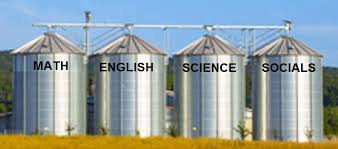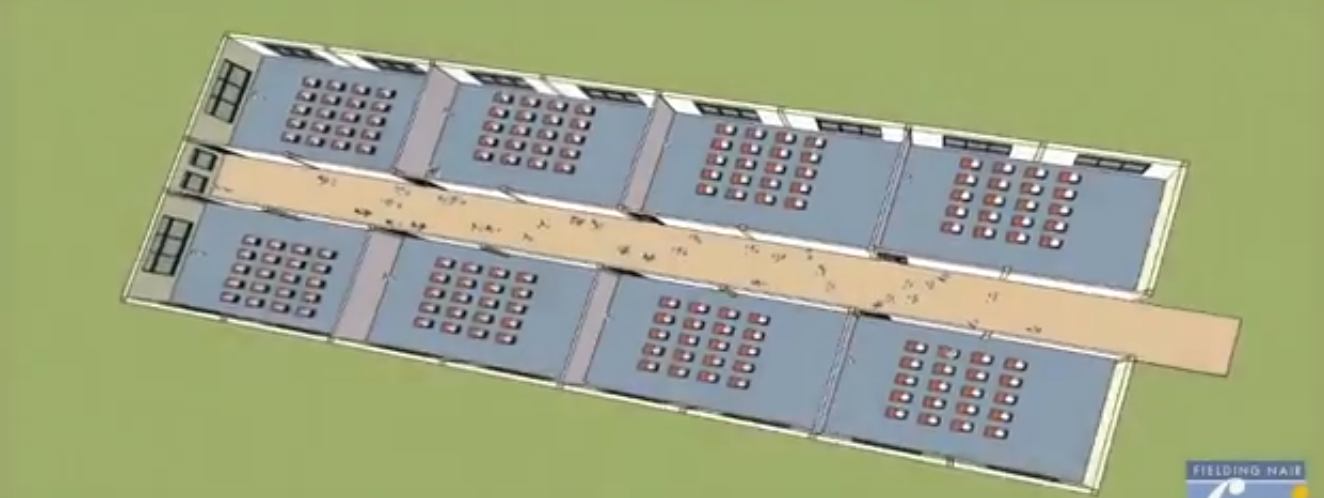From "cells and bells" to Smaller Learning Communities
Image above - from institutional style cafeteria to "espresso cafe" - design by Fielding Nair International.
|
|
|

It is time to lose the "cells and bells" and the siloed, Pac-Man Curriculum!
How could your schools be transformed from the factory model of "cells and bells" to Smaller Learning Communities? Let's take a look at the diagram below. Or sketch it on a large piece of paper, and begin playing with the configuration. Use the videos above as guide and inspiration.
Remember, an SLC (Smaller Learning Community) should include no more than 125-150 students. This group of students will work with a designated, interdisciplinary team of teachers. A good way to organize this for high schools is to have the SLC meet each day for half a day in an interdisciplinary, project-based curriculum, OR you can go a step further and implement a project-based curriculum that is student-driven. In this mode, each student designs his own project and the teachers are facilitators.
In both modes, the group-based interdisciplinary project, or the student-designed project, the students spend half a day on their projects and spend half a day on other classes and courses. Both modes also ensure that all content standards and district policies on graduation are not only met, but exceeded. It is not a free-for-all, but is highly organized and planned in detail.
For example, in this corridor which is lined with classrooms, you could select four to six classrooms to convert into an SLC. The walls separating the classrooms would be removed and replaced with movable walls, preferably glass to keep the feeling of the entire community intact. Walls and furniture would be movable as needed, depending upon the learning needs of the moment.
The hallway would be incorporated into the entire space. There would be a large learning commons and some alternative spaces. You should also consider include some of the following spaces in your SLC. Ensure as many connections and flow to the outdoors!
One or two of the classrooms would become the Teacher Collaboration Area. It is in close proximity to the students - with in the SLC. it would include large windows, if not glass walls, for transparency and more connectedness to the students. it could include individual teacher's desks, or a large conference table.
There would be ample storage space, whiteboards for planning, places for storage of personal items and a location to make private telephone calls.
It should also include a view of the outdoors, nature.
Academies
Many schools, from elementary through high school, create Academies for their SLCs. Here are a few ideas to consider. Students may request the academy which they prefer. The academies may be within a single grade level, or they can include multiple grade levels. The SLCs and project-based, interdisciplinary learning will support teachers as facilitators, and this will enable total differentiation as well as personalization for the students in the SLC/Academy.
Each Academy may offer a core foundation of courses and real-world learning experiences for every student. At the end of each major, students may participate in some type of capstone, internship, and/or practicum program.
Each Academy may offer a core foundation of courses and real-world learning experiences for every student. At the end of each major, students may participate in some type of capstone, internship, and/or practicum program.
CTE Academy - Career Technical Education could include Architecture, Construction, Culinary Arts, Engineering, Software Development, Video Game Production, Robotics and more. For additional ideas see this page featuring recommended Career Clusters and standards.
Arts and Humanities Academy - Language arts, social studies, world languages as well as courses in the performing arts may be the basis of this academy. Courses may include Drama, Fashion, Photography, RTF (Radio, Television and Film), Music, Costume Design and Dance. Hands on journalism experiences as well as participation in a Model UN or Mock Trial event, world language competitions and international travel are valuable components of this program.
Capstone Projects will be creative and original projects that will include (but not be limited to): connections among disciplines; evidence of community or professional collaboration; evidence of understanding of global citizenry; formal written component; research into topic; and presentation to teachers, administrators, and/or outside evaluators.
Capstone Projects will be creative and original projects that will include (but not be limited to): connections among disciplines; evidence of community or professional collaboration; evidence of understanding of global citizenry; formal written component; research into topic; and presentation to teachers, administrators, and/or outside evaluators.
STEAM Academy - The National Academy of Engineers has identified 14 Grand Challenges that the world faces in this century. From careers at NASA or SpaceX to careers in filmmaking there are abundant possibilities for Science, Technology, Engineering, Art and Math.
Students will develop 21st century skills in an interdisciplinary, project-based curriculum. Here are some project ideas (some may overlap with other academies listed on this page.) Read about this innovative, exciting STEAM Academy.
Students will develop 21st century skills in an interdisciplinary, project-based curriculum. Here are some project ideas (some may overlap with other academies listed on this page.) Read about this innovative, exciting STEAM Academy.
Health Sciences Academy - preparing students for careers in the health sciences. This field is expected to grow dramatically over the next twenty years.
See this academy and the type of grants they obtained. This should provide you with some ideas of the types of grants you may persue to make your Health Sciences Academy spectacular.
See this academy and the type of grants they obtained. This should provide you with some ideas of the types of grants you may persue to make your Health Sciences Academy spectacular.
Business Academy or the Entrepreneur Academy - careers involving persuasion, military leadership, data management, accounting, marketing, advertising, criminal justice, commerce, and business procedures. This academy enables a diverse community of learners to explore business and professional opportunities and build partnerships using community resources.
See this program from Virginia Beach City Public Schools, and this from the Young Entrepreneurs Academy.
See this program from Virginia Beach City Public Schools, and this from the Young Entrepreneurs Academy.
Environmental Studies -
Global Studies Academy - for students who want to know and experience the world and the people in it! Careers abound which require literacy in Global Competencies. For student who desire world travel, either physically or virtually, there are many possibilities. From careers in education (teaching and administration) there are international schools everywhere, to a career with the CIA - Central Intelligence Agency of the USA, to careers with the US State Department working in an embassy, as a diplomat.
One requirement for some of these jobs is that the student be multi-lingual. If you do not have an army of teachers for various languages at your school, there are online options.
One requirement for some of these jobs is that the student be multi-lingual. If you do not have an army of teachers for various languages at your school, there are online options.
